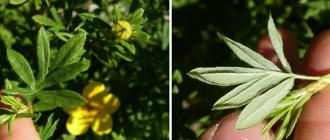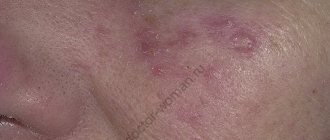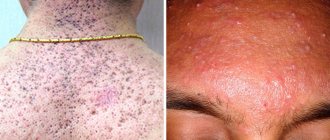The article was prepared by a specialist for informational purposes only. We urge you not to self-medicate. When the first symptoms appear, consult a doctor.
Thyme is a perennial subshrub plant (5–40 cm high) with thin stems that grow along the ground. The leaves are small, thin, oval-shaped, green. The flowers are also small, pinkish-purple, very beautiful. They are collected in the form of bunches at the ends of the branches. The fruits of the plant are 4 nuts located at the bottom of the cup. Thyme is very fragrant and during the flowering period attracts many bees and butterflies. Propagated by seeds or vegetatively.
The flowering period of thyme is June-July. The fruits ripen in August-September. This grass grows in the European part of Russia, the Caucasus, Kazakhstan, Western Siberia, Transbaikalia, and Ukraine.
Thyme can be found on the slopes of ravines or ravines, in forests; it loves sandy soil. On plowed ground it grows strongly, creeping over hummocks. In spacious meadows you can find large thickets of thyme of a very beautiful pinkish or purple color.
Are thyme and thyme the same thing? Thyme and thyme are varieties of the same plant. They are similar in taste and range of useful properties. A low-growing shrub with the Latin name Thýmus has different definitions, depending on the area of growth. Thyme is a variety common in Ukraine.
The plants are very similar in appearance, but in thyme the root system goes deep into the soil, while in thyme it spreads along the surface of the soil. Thyme has a denser, spherical crown. Thyme is more herbaceous.
What does thyme taste like? Taste shades may differ depending on the type of thyme - ordinary or lemon. It has woody, spicy, sweetish-spicy notes. Some dishes reveal its bright mint or pepper flavor.
If the taste of thyme is revealed differently for everyone, then its aroma cannot be confused with any other spice. Its fragrant greenery is added to aroma lamps and baths. Lemon thyme has a citrus aroma. Common thyme gives off pine and light camphor notes.
[Video] Herbalist Sergei Viktorovich Moryakov talks about thyme:
- Thyme for cough
- Storage
- Side effects if the dosage is violated
The benefits of thyme for the body
The healing properties of thyme have been known since ancient times. This plant contains many useful elements, such as bitter and tannin substances, resins, gum, fats, ursolic and oleic acids, vitamins B and C. Its beneficial properties are manifested in antiseptic, wound healing and disinfectant effects on the human body. The herb has found its use in cosmetology, medicine, and the food industry.
In traditional and folk medicine, thyme is used in the form of infusions and extracts, decoctions and tea to treat:
- Pulmonary and bronchial infections accompanied by an inflammatory process.
- Gastritis.
- Digestive disorders and normalization of intestinal microflora.
- Neuralgia, radiculitis.
- Migraine.
- Nervous conditions, depression.
- Sleep disorders.
For external use, dry or fresh thyme raw materials are added to creams and infusions. Essential oils and alcohol tinctures are prepared from flower inflorescences.
Compound
The main components of the chemical composition of thyme are carvacrol, thymol, borneol and p-cymene. The proportion of these components can be 85%, 42%, 59% and 23%, respectively.
Carvacrol and γ-terpinene were identified as the main volatile components of the oil.
The energy value of 100 grams of fresh thyme is 101 kcal, due to the presence of basic substances:
- Protein - 5.56 g.
- Fats - 1.68 g.
- Carbohydrates - 24.45 g.
- Fiber - 14 g.
Among the saturated fatty acids, the following should be distinguished:
- Caprylic.
- Lauric.
- Myristic.
- Stearic.
- Palmitic.
Unsaturated acids are represented by:
- Omega-3 (alpha-linolenic).
- Omega-6 (linoleic).
- Omega-9 (oleic)
14 healing properties of thyme
- Normalizes heart function. Several medical studies have found that thyme improves heart function. Experiments on rats with established high blood pressure showed that thyme extract reduces heart rate [1]. The results obtained give hope for a similar effect in people. In addition, it was found that thyme reduces cholesterol levels [2].
Today, doctors recommend replacing salt with thyme when cooking. Simple changes will have a beneficial effect on lowering blood pressure.
One of the observations led to the conclusion that thyme is extremely useful for atherosclerosis, which remains the main risk factor for heart and vascular diseases.
- Has anti-cancer properties. Portuguese scientists have found that consuming thyme prevents the development of tumor processes, especially colon cancer. Today, this quality is explained by the action of oleanolic and ursolic acid, beta-sitosterol and lutein [3].
One study found that thyme is beneficial for breast cancer. The herb significantly speeds up treatment and promotes the death of altered cells.
The most important compound found in thyme essential oil is carvacrol. Medical experiments confirm that carvacrol suppresses the proliferation mechanism and migration of cancer cells. It has been proven that the phytoelement has a positive effect on cancer treatment and can act as a preventive substance. To a large extent, this applies to colon cancer [4].
- Suppresses the inflammatory process. The presence of a specific inflammatory enzyme, COX-2, plays a major role in the occurrence of an inflammatory focus. It turned out that thyme oil can suppress its activity due to the presence of carvacrol in the composition [5]. Scientists have found that carvacorl, like the red wine element resveratrol, has a positive effect on health.
A parallel study showed that carvacrol and thymol, which are found in thyme, counteract the development of inflammation. Therefore, essential oil is used externally to relieve painful manifestations of gout and inflammatory joint diseases [6].
- Increases immune functions. Thyme contains a lot of vitamin C, which is directly associated with immunity. Vitamin A also has a positive effect on the body's protective functions. The combination of vitamins helps suppress colds at the very beginning of the incubation period.
The active substances of thyme take part in the synthesis of leukocytes, which are the basis of immunity [7]. At the same time, anti-inflammatory properties help strengthen the body's protective functions. Thyme is recommended for steam inhalation for colds and nasal congestion. The pleasant smell and mild taste make the procedures very pleasant [8].
Thyme contains substances that accelerate regeneration processes. Local use of the plant stimulates the healing processes of open wounds [9].
- Helps in the treatment of dyspraxia. Dyspraxia (apraxia) is a disease that is characterized as a violation of purposeful motor acts while maintaining elementary movements. The neurological disorder is associated with damage to the cerebral hemispheres. Studies have shown that thyme relieves the symptoms of dyspraxia, and the positive result is especially noticeable in children.
The essential oil was used to study the effects of thyme on neurological diseases, including dyspraxia [10]. The results of the experiments were promising, which prompted the initiation of additional studies to obtain more extensive data.
- Improves the functions of the digestive system Plant fibers of thyme suppress gas formation, which greatly facilitates digestion and protects the walls of the stomach [11]. The carminative property is inherent in the essential oils of this plant. Thyme can be used for intestinal spasms, as it has an antispasmodic effect.
- Effective for respiratory diseases. Thanks to its ability to activate the immune system, thyme copes well with respiratory diseases. Since the time of Hippocrates, it has been used to treat coughs and bronchitis. In modern Germany, thyme is recommended by official regulatory authorities for respiratory symptoms [12].
One of the experiments proved the therapeutic effect of using thyme and ivy leaves in relieving coughing attacks and other symptoms of bronchitis in the acute stage. In addition, thyme tea has been found to soothe a sore throat [13].
- Relieves menstrual pain. Observations by gynecologists have shown that thyme alleviates a woman’s condition with dysmenorrhea, which is characterized by attacks of cramping abdominal pain [14]. It should be noted that thyme is allowed for girls and women of any age.
- Improves vision. As we said earlier, thyme contains a record amount of vitamin A, which is especially beneficial for eye health and the quality of vision. Lack of vitamin A is one of the main causes of night blindness, a condition in which a person has difficulty seeing in twilight, darkness, or when the lighting changes. Thyme helps solve this problem, as well as prevent vision impairment and macular degeneration, which has been proven by ophthalmological studies [15].
- Takes care of the oral cavity. The results of several studies suggest that thyme suppresses the proliferation of pathogenic flora and helps fight oral infections. Thyme essential oil has shown effectiveness against bacteria that have become resistant to antibiotics [16].
Thyme oil has an antiseptic effect against pathogens that can multiply in the mouth [17]. Therefore, it is used to treat gingivitis, caries, as well as to eliminate plaque and unpleasant odor. In professional dental practice, thymol, which is part of thyme, is used. It is used as a varnish to be applied to teeth to preserve their integrity.
For the purpose of treatment or prevention, you can use thyme as a mouth rinse. To do this, just add one drop of essential oil to a glass of warm water and rinse your mouth thoroughly without swallowing the liquid.
- Relieves headaches. One of the components of thyme - carvacrol - deserves special attention. It inhibits the action of cyclooxygenase enzymes, which play a key role in the development of inflammation. Carvacrol has an effect similar to the effect of taking a non-steroidal anti-inflammatory drug, i.e. it relieves pain and eliminates the source of inflammation.
To obtain the necessary therapeutic effect, apply a few drops of thyme oil to the temples and forehead area, rub into the skin with light massage movements. Maintain a calm position until relief occurs.
Thyme essential oil helps cope with stress, protects cells from oxidation, and removes toxins. When inhaled, it has a beneficial effect on the psycho-emotional state.
- Improves your health skin. In relation to the skin, thyme essential oil has antifungal and antibacterial effects. This allows it to be used at home as a remedy for acne, as well as to treat wounds, skin ulcers, superficial scars and cuts. Thyme oil has been proven to help with burns and skin rashes.
One of the most unpleasant skin diseases is eczema. It is manifested by dryness, the formation of scales, which are replaced by blisters, itching, and cracking of the skin. The cause of eczema often lies in digestive problems and chronic nervous stress. Thyme successfully fights both the manifestations of the disease itself and acts on the root causes.
It has been noticed that the use of thyme, rich in powerful antioxidants, helps maintain youthful skin and restore a healthy, radiant appearance to the face.
- Improves hair condition. Combining thyme oil with other plant oils or extracts promotes hair growth. Research suggests that a combination of thyme and lavender oils significantly improves hair condition after 6-7 months of regular external use [18].
- Improves mood. Animal studies have shown that thyme, and carvacrol in particular, increases levels of dopamine and serotonin in the hippocampus and prefrontal cortex. As you know, dopamine and serotonin are the main neurotransmitters that shape mood.
Results published in 2013 show that carvacrol is an active molecule that affects cognitive processes and helps combat anxiety. So far, this feature of thyme has been studied in animals, but the data obtained give hope that soon people will receive a safe antidepressant.
Benefits for men
The rich vitamin and mineral composition of thyme explains the wide range of its effects on the human body. Research by urologists and andrologists suggests that thyme is effective in treating diseases of the male genitourinary system. The effectiveness of thyme herbal remedies has been proven in relation to:
- Prostatitis.
- Prostate adenomas.
Essential oils, flavonoids and tannins have an anti-inflammatory, antibacterial effect, protect cells from malignant degeneration. Thymol and ascorbic acid have a normalizing effect on hormonal levels. For treatment purposes, thyme infusion is taken internally, and tea is taken as a preventative measure.
Phytocompounds in thyme stimulate blood circulation in the pelvis, which has a positive effect on male potency. To treat erectile dysfunction, take tea from thyme leaves orally and rub essential oil into the groin area.
Considering the fact that men are more susceptible to heavy physical labor or intense sports activities, baths with thyme decoction are especially recommended for them. This spa procedure helps relieve tension, relax muscles, get rid of pain, and improve well-being.
Benefits for women
Thyme can safely be called a female herb. It not only eases the period of painful menstruation, but also has a beneficial effect on a woman’s hormonal levels. This effect is especially important during menopause. Tea helps cope with hot flashes, normalizes a woman’s psycho-emotional state, and prevents the development of osteoporosis. It has been proven that thyme relieves premenstrual syndrome and activates the synthesis of female sex hormones.
Due to its antibacterial and anti-inflammatory effects, thyme decoctions are recommended for thrush and cystitis. External baths and douching help with urethritis, vaginitis, inflammation and burning in the genital area.
And if thyme is contraindicated during pregnancy, then during breastfeeding it is an indispensable assistant. Thyme tea has a complex effect on a woman’s body in the postpartum period:
- Helps recovery.
- Stimulates the production of breast milk.
- Prevents the development of infections.
- Replenishes vitamins and minerals.
Thyme for children
Nowadays, many parents prefer to use drugs from natural plants in the treatment of their young children, since synthetic drugs have a lot of side effects and contraindications. One such beneficial herb is thyme. It has a soothing, disinfectant and antiseptic effect. If a child does not sleep well, then it is enough to take a warm bath with thyme - and the baby’s sleep will be healthy and calm. Baths also help well with rickets and rheumatism.
But when treating with herbs, you should definitely follow the recommendations of homeopaths. Proper use of natural medicines gives the best healing effect.
Application in cosmetology
Dermatologists and cosmetologists use thyme-based products to achieve a rejuvenating effect, treat inflammatory skin diseases, and restore hair structure. Thyme is included in caring creams, lotions, anti-aging masks, and shampoos.
At home, thyme is very easy to use. We present simple but very effective recipes that are easy to prepare yourself:
- Hair rinse - helps strengthen hair follicles and get rid of dandruff. You need to take 4 tablespoons of thyme herb and pour 0.5 liters of boiling water. Cover the dish with a lid and place in a water bath for 30 minutes. Next, let the broth cool and strain. Apply the resulting product to your hair twice a week, regardless of shampooing.
- Soothing facial lotion - use morning and evening. To prepare, take equal parts of chamomile and thyme flowers, add hot water (not boiling water), stir, and cover with a lid. After 15 minutes, strain the resulting mixture through a double layer of gauze.
- Anti-inflammatory compresses for the skin - relieve redness and irritation. Take 1 tablespoon of thyme, brew with hot water and infuse to a comfortable temperature. After straining in the liquid, moisten a napkin made of natural fabric and apply it to the face for 15-20 minutes.
- Hair mask - helps stop hair loss, stimulates hair follicles. For preparation, take oak bark (20 g), willow bark (20 g), thyme (20 g). All components are mixed, poured with hot water and kept in a steam bath for 10 minutes. The resulting broth is cooled and filtered. The product is rubbed into the hair roots, covered with a plastic cap, and wrapped in a towel for 20-30 minutes. After this, rinse your head with warm water.
- Anti-acne remedy. Take thyme and witch hazel in equal parts and add hot water. After 20 minutes, filter the infusion. Apply to problem areas using a cotton pad, after 20 minutes rinse your face with cool water.
Choosing a growing location and soil
Thyme, like any plant, has certain growing requirements that must be met to ensure its best development. In the garden this should be a place:
- sunny, bright;
- warm;
- protected from the wind.
Ideally, the sun should shine on the plant for at least half a day. In addition to light, the plant needs a lot of heat. Therefore, it readily grows near walls and stones, which heat up and then return solar energy.
Attention! It is better to choose a higher place for growing thyme. This plant does not like soaking. It is important that plants, especially young ones, are not flooded in the spring. Especially early varieties that lie on the ground like moss.
The soil for growing thyme should be:
- fertile;
- air;
- rich in calcium;
- rich in humus and essential nutrients;
- permeable, preferably sandy;
- well loosened;
- warm.
The plant will also cope with weaker soils.
A limestone substrate is excellent for growing thyme. The soil intended for planting should not be acidic (if necessary, liming may be required before planting) and should not be too wet or too dry, in such areas the plants will grow very poorly or die.
The plant suffers greatly from weeds; it is most vulnerable at the very beginning of cultivation, when young seedlings have not yet had time to take root and branch well. Therefore, before planting thyme, the area should first be thoroughly cleared of weeds and dug deep.
Good predecessors for thyme (cultures after which it is better to plant):
- roots;
- vegetables;
- rape;
- green legumes.
Despite the fact that thyme does not have high nutritional requirements, before cultivating it, mineral fertilizers can be added to the soil in an amount of approximately 400-500 g/area P₂O5, 500-600 g/area K2O (before planting on a plantation) and 400-600 g/acre N in two doses before planting and for fertilizing.
Thyme in a pot on a windowsill in an apartment should also be grown on fairly fertile soil and preferably placed on a southern windowsill. From May you can take it outside, making sure that it does not freeze.
How to make tea with thyme?
Want to use thyme to improve your health? There is nothing simpler - prepare tea from fresh whole or crushed leaves, dry raw materials. It is better to strain the finished drink so that parts of the leaves do not fall into the cup.
If you have fresh thyme, place a few sprigs in a glass or teapot and cover with boiling water. Leave for up to 10 minutes. If desired, you can strain the finished drink so that the leaves do not fall into the cup.
If you have ground thyme, take 1 teaspoon of the raw material, pour a glass of boiling water, mix well. After 10-15 minutes the drink is ready.
[Video] Tea with thyme (removing mucus from the lungs after a cold):
To treat colds, thyme can be combined with other herbs. In addition, thyme tea itself is very tasty and has a wonderful aroma.
- Recipe 1. Pour 1 teaspoon of thyme into a quarter glass of water, bring to a boil and let it brew for 10 minutes. You can pour boiling water right away. After steeping, the tea should be strained.
- Recipe 2. Three spoons of black tea and two spoons of thyme should be placed in a teapot, pour boiling water and leave for 2 minutes.
- Recipe 3. Pour a glass of boiling water over a mixture of lingonberries, St. John's wort and thyme (ratio 1:1:1) and let it brew for 15 minutes.
Reproduction
If breeding is necessary, thyme can be propagated in several ways. In the natural environment, thyme reproduces using seeds. While in decorative use the method of dividing the bush or cuttings is more often used.
Seed propagation
Sowing is a simple way to obtain a new plant, since the shrub takes root easily and grows quickly. At the same time, thyme seeds can be collected from an adult bush or purchased in specialized stores.
You may be interested in: Hydrangea in the garden: choosing types and varieties 150 photos
Sowing can be done in open ground and in containers to obtain seedlings. Depending on the sowing method, planting is carried out in spring or autumn.
Sowing in open ground is carried out in the fall, when constant warmth is maintained and there is no frost. At the same time, the seeds are evenly distributed over the soil surface. In the first days after sowing, it is preferable to cover the planting site with covering material. Sowing is carried out in a mixture of sand and peat. After planting, the plants are provided with regular watering and weed removal.
When growing seedlings, sowing in containers is carried out in the spring, at the end of March or beginning of April. When sowing, thyme is distributed over the surface of the soil mixture, after watering the ground with water. After planting the plants, the containers are covered with film and placed in a warm, sunny place until shoots emerge. After the appearance of three or more permanent leaves and with the onset of constant warmth, the plants are planted in a permanent habitat.
Dividing the bush
Dividing the bush is the best option when you need to get one daughter plant. An adult plant is used as a mother plant. Breeding is carried out in the spring, before a large amount of foliage forms. At the same time, the mother plant is dug out of the ground and carefully distributed into equal parts. The resulting parts are planted in a permanent habitat.
Cuttings
Thyme can also be propagated using cuttings. This method can be used at any time of the year. When does the bush grow? To do this, a branch with several shoots is cut from an adult and the cutting is placed in moist soil. To improve the growing season, cover the cuttings with a cut plastic bottle or jar. After new leaves appear on the branch, the plant can be planted in a permanent habitat.
What herbs goes well with thyme?
Traditional medicine experts recommend combining thyme with other medicinal herbs:
- Rosemary - activates the analgesic, antifungal and antibacterial effects of thyme. This combination is recommended for men to treat impotence.
- Ivan tea or fireweed - enhances the sedative effect, complements the anticonvulsant properties of thyme.
- Sage - promotes a more pronounced expectorant, anti-inflammatory effect.
- Chamomile - indicated in combination with thyme in the treatment of colds, flu, and diseases of the male urological area.
- Oregano - in combination with thyme, is indicated for the treatment of gynecological disorders, infertility, thrush, cystitis. Effective in the treatment of bronchopulmonary diseases, whooping cough.
- Mint - enhances the antifungal and antioxidant properties of thyme. The combination of herbs helps alleviate the symptoms of hypertension, diseases of the cardiovascular system, and ophthalmological disorders.
[Video] What is the difference between oregano, thyme, oregano, thyme and marjoram?
Medicinal and beneficial properties
Briefly, what are the benefits of thyme:
- Calms the nervous system, relieves insomnia.
- Improves the functioning of the intestines and stomach.
- Protects liver cells from destruction.
- Removes toxins and impurities.
- Normalizes blood pressure.
- Helps the body fight viruses, bacteria, fungi.
- Accelerates the restoration of damaged tissues.
- Activates the urinary system.
- Strengthens the walls of blood vessels.
- Tones the body.
- Reduces the likelihood of developing cancer.
- Accelerates relief from colds, eases the course of pathologies of the respiratory system.
For treatment, the above-ground part of the plant is used - young stems, blossoming buds and leaves. The daily intake for an adult is 1 tablespoon of dry raw materials or 4 cups of thyme tea. Depending on the pathology, the dosage may be reduced or temporarily increased. Continue thyme therapy for up to 2 weeks. Then take a break for 5–10 days.
Features of benefits for women and men
Useful properties of thyme for women:
- Elimination of negative symptoms of menopause. Regular consumption of herbal drinks helps fight hot flashes, mood swings, and brittle bones.
- Normalization of the monthly cycle, elimination of premenstrual syndrome. Tea with thyme stimulates the production of female sex hormones, reduces the intensity of spasms, and eliminates headaches.
- Relief of well-being with cystitis, thrush. Drinking thyme drinks helps relieve discomfort when urinating, remove inflammation, and stop the spread of infection. Hygienic procedures for the intimate area and douching with decoctions and infusions of thyme eliminate itching and inflammation of the external genitalia.
Benefits of thyme for men:
- Reducing the risk of developing and treating prostatitis. The plant improves blood circulation in the pelvic area, eliminates infections and bacteria that contribute to the appearance of pathology. Use thyme infusion for therapy, and tea for prevention.
- Improving potency. Thyme contains molybdenum and selenium, which accelerate the production of male sex hormones and eliminate erectile dysfunction. The plant helps to get rid of stress and bring the psychological state back to normal. For treatment, you can take tea or rub thyme essential oil into the groin area.
- Eliminate muscle soreness and tension. During heavy physical activity, baths with thyme infusion help to forget about unpleasant sensations in the body and regain strength.
Use of thyme
Thyme is used not only in folk, but also in official medicine. It is part of a children's cough medicine called Pertusin. When stung by bees, thyme lotions relieve swelling and pain. Decoctions and extracts from the plant are prescribed for asthma and tuberculosis. This is an excellent sedative for depression, fatigue, and neurasthenia. A decoction of thyme helps with bad breath. Essential oil is used as an air disinfectant.
Thyme is also successfully used for coughs, bronchitis, asthma, tuberculosis, whooping cough, atony and intestinal spasms, and bloating. It effectively fights diseases such as articular and muscular rheumatism, copes well with the consequences of bruises and non-infectious rashes on the body. The plant is included in herbal preparations intended to relieve chronic fatigue syndrome.
Thyme preparations are indispensable for men's health. They prevent the development of prostatitis, eliminate sexual impotence and prevent premature ejaculation. In cooking, thyme is added to all foods (potatoes, legumes, sausage, fatty meat) when it is necessary to facilitate the absorption of difficult-to-digest food.
Thyme for cough
Infusions and decoctions of thyme have a disinfectant and expectorant effect. They are prescribed for respiratory diseases, colds, asthma and sore throat.
- Recipe 1. Pour one tablespoon of dry thyme into one glass of hot water, let it brew for one hour, then strain. Take the medicine 1-2 tablespoons three times a day.
- Recipe 2. Mix fresh aloe juice with honey and 1 tablespoon of thyme infusion in a 1:1 ratio. Drink the resulting medicine.
- Recipe 3. 3-4 tablespoons of thyme must be mixed with oregano and mint, 1 spoon each, pour boiling water, leave overnight. Drink the product like tea.
- Recipe 4. Immediately after preparation, the decoction or infusion should be left in the container without straining, and a towel should be thrown over the head. You need to breathe over the steam for about 15 minutes, then cover your neck with a warm scarf or scarf; immediately after the procedure it is not recommended to go outside.
Thyme for alcoholism
Unfortunately, alcoholism is a terrible disease of our people. But it can be cured with thyme. A decoction of the plant contains thymol, which causes vomiting in case of overdose. The effect of thyme decoction is based on this.
Recipe. 15 g of thyme is poured into 250 ml of boiling water, left in a water bath for 10–15 minutes, after which the first infusion is drained and the same amount of water is added again. Take a decoction of 50–70 ml several times a day, after which the patient should be given approximately 25 g of vodka to drink. Before drinking vodka, you need to sniff it for 5 minutes. 10–30 minutes after drinking the vodka, a reaction occurs: the patient experiences nausea or even vomiting.
Treatment usually lasts 1–2 weeks, and as a result the patient develops a persistent aversion to alcohol. Be sure to use only fresh decoction.
Thyme for blood pressure
Thyme is often used in herbal remedies for hypertension, so people suffering from high blood pressure may benefit from drinking thyme tea. It dilates blood vessels.
- Recipe. Pour one tablespoon of herbal mixture into a glass of boiling water, let it brew for several hours and drink before meals three to four times a day. After drinking, you need to lie down and apply a warm heating pad to your feet.
Other thyme recipes
- Recipe 1. Pour boiling water over chopped thyme and boil in a water bath for 20–30 minutes. Then cool and strain. The ratio of thyme and water is 1:10. This thyme decoction is recommended for stomach cancer.
- Recipe 2. Add one tablespoon of thyme to 400 ml of water, bring to a boil, cool and strain. You should drink half a glass three times a day. This decoction is used for dysbiosis, headaches, loss of sleep and overexertion.
- Recipe 3. Infusion for dandruff and hair loss. Pour one tablespoon of dry crushed thyme into 250 ml of boiling water, let it brew for 1 hour and drink 70 g three times a day.
- Recipe 4. Bath infusion. You need to pour 100 g of thyme into five liters of boiling water, let it sit for 30 minutes, and pour it into the bath. Bathing should be repeated twice a week.
- Recipe 5. Tincture as a flu prevention. For 50 g of dry thyme, take 220 ml of 70% alcohol, leave for 10 days in a dark, cool room in a glass container at a temperature of 20–25 °C, shaking once every two days. The maximum shelf life of the tincture is five years.
- Recipe 6. Prevention of influenza. 20 g of thyme herb, mint leaves and fragrant violet flowers should be poured with 500 ml of vodka, left for 3-4 days, shaking at least twice every day. Then strain the medicine.
Uses of thyme oil
Thyme oil contains tannins, resins, malic and acetic acids, and mineral salts. The oil is obtained from the thyme herb. The oil also contains thymol, which has antiseptic and anthelmintic properties. The oil is used for various ailments. It is effective for skin diseases, helps with headaches, stomach pain, and joint diseases. The oil has a good effect on respiratory diseases, including tuberculosis and asthma.
Thyme oil is practically irreplaceable if you suffer from insomnia, headaches and depression. It helps with hair loss, besides, it improves memory and increases attention.
Uses of thyme essential oil
The essential oil is obtained by steam distillation of thyme flowers. Thanks to its expectorant, warming and anti-inflammatory properties, thyme oil has a beneficial effect on respiratory diseases. This is an excellent remedy for the treatment of genitourinary infections and inflammations.
With its help, you can easily cope with women's diseases such as pain and menstrual irregularities. Essential oil stimulates contractions, and the baby is born faster. Thyme is susceptible to problems with the gastrointestinal tract, and in addition, it improves appetite, elevates mood, relieves fatigue, increases alertness and tones the nervous system.
Correct preparation
If you decide to independently prepare several bunches of this herb for the winter, then you will be interested in learning how to do this effectively, and how not to spoil the entire harvest. We will go through the collection, drying and storage procedure step by step.
If you are worried that something might not work out, then you are mistaken. It is enough to follow the elementary instructions, not to invent something that has already been invented. Compliance with the algorithm is a guarantee of success.
Collection
In fact, collecting thyme is not so difficult as not destroying it. Do not cut the plant at the root, this will disrupt its growth and assimilation. Take care of nature, and it will reciprocate.
- Collection is carried out from mid-May to the end of August, during the flowering period.
- The more flowers a plant has, the more fragrant and healthy it is.
- If bees are flying around, then the harvest time is perfect and the plant is a honey plant.
- Thyme should be collected in the afternoon, when all the dew has subsided.
Here are some simple assembly instructions. It’s not difficult to follow, and there shouldn’t be any problems. All you have to do is find a clearing where there will be a lot of it, and you can choose the best grass.
Drying
You can also dry your collection without any problems. There are only three recommendations that must be strictly followed.
- Do not dry in the sun, the properties will be lost.
- Stir while drying. This way you won't end up with rotten herbs.
- Drying should be carried out in a dry room without condensation. Rotting is the biggest problem in this process.
If you follow these three postulates, you will end up with aromatic herbs from which you will prepare teas, infusions and decoctions.
Storage
- It is preferable to store thyme in bunches, as it is preserved better this way.
- Store it in a place where no one can crush it. Dry leaves can turn into dust if handled roughly.
- Try to use everything you have prepared within a year. Fresh tea from the plant is better than one year old.
The finished dry collection has a delicious aroma that intensifies when rubbed. It's time to talk about sad things, about contraindications.
How to make cough syrup from thyme?
Thyme cough syrup is no worse, and maybe even better, than the synthetic medicines that we are all used to using, because the syrup is prepared from natural ingredients.
- Recipe 1. A small bunch of still blooming thyme should be washed well, finely chopped and allowed to dry. Then the raw material needs to be poured with about 450 ml of water and simmered over low heat, the water should boil by half. The broth should be allowed to cool, then strain it, add about 50 g of garlic (squeeze out the juice) and 300 g of natural honey. Mix everything and store in a tightly sealed container. You need to take the medicine after meals, 1 teaspoon per day. This syrup can be stored for a very long time.
- Recipe 2. Finely chop 20 g of dry thyme, pour in about 200 ml of hot water, cook over low heat in a closed saucepan until the water boils by half. Dissolve 200 g of honey in a water bath and add it to the decoction. The syrup turns out very tasty. Children can be given this medicine after meals, 1 teaspoon.
- Recipe 3. Flowering thyme must be cut and placed in a glass jar in layers, alternating thyme with sugar, pressed down and left in a dark place for two weeks. Then the syrup is poured into another jar and covered tightly with a lid. Add the product to tea if you have stomach problems.
Is it possible for children
It is not recommended to give herbal drinks to children under 3 years of age. But from birth you can bathe your child with thyme infusions.
Pros of baths with thyme:
- improved sleep;
- increased appetite;
- getting rid of sweat rash, diaper rash;
- normalization of intestinal function;
- eliminating anxiety.
Babies are bathed in herbal infusions 1-2 times a week. Doctors, including the popular Dr. Komarovsky, recommend starting procedures after the umbilical wound has healed. From the age of 3, children are allowed to drink tea with thyme for colds. The herb helps relieve cough, reduce fever, and eliminate sore throat. Children under 6 years old can drink 50 ml of the drink 2 times a day. For schoolchildren, the dose is increased to 100 ml 2 times a day.
How to collect, how to dry?
Thyme begins to be collected between flowering and seed formation, which corresponds to the calendar period from June to August.
If you want to collect thyme for the first time, use the recommendations of professionals:
- Cut the stems along with the concrete at a level of 3-4 cm from the soil level.
- Choose stems with a lot of flowers.
- Avoid plants that show visible signs of insect damage.
- Spread the herbal raw materials in a loose, thin layer on a prepared, clean surface.
- The drying process should take place under natural conditions, outdoors in the shade or in a ventilated area.
- Dried stems should crumble easily when squeezed.
[Video] Collecting thyme:
Storage
Freshly picked thyme is stored in the refrigerator. The leaves begin to change color as the collected grass ages. To preserve its valuable properties, thyme is frozen and later used as a spice in first courses and when stewing meat. Dried raw thyme is stored for a year at room conditions. After 12 months, the grass loses its fragrant aroma.
Pharmaceutical preparations of thyme in capsules contain ground leaves. They are stored at room temperature and taken 250-500 mg per day.
Thyme essential oil can be found in pharmacies. It is produced in dark glass bottles. Essential oil is stored in a dry, cool place or in the refrigerator, protected from direct sunlight.
Kinds
The genus contains more than 200 species.
Within the species there are 2 subspecies:
- vulgaris – nominative subspecies,
- aestivus (Willk.) - known from Spain.
The most common:
- Creeping thyme (Thymus serpyllum L.).
- T. Marshall (Thymus marschallianus Willd.).
- Some species are listed in the Red Book - T. beautiful (Thymus pulchellus) and T. Taliev (Thymus talijevii).
There are mainly 2 types used in cooking:
- Common (Thymus vulgaris);
- Lemon-scented (Thymus citriodorus).
Let's take a closer look at them.
Ordinary
Common thyme (Thymus vulgaris) is a plant with rigid, erect stems, from which small, narrow, elliptical, gray-green leaves grow in pairs. The leaves are sometimes rusty-red below, the length does not exceed 5-10 mm. It blooms with pink and white flowers growing in a spiral at the ends of the branches, making the plant extremely attractive to insects, especially bees. It is characterized by a sharp, refreshing taste and spicy, bright aroma.
Common thyme, photo
Creeping
Creeping thyme (Thymus serpyllum) is a low creeping evergreen shrub, reaching a height of 5 cm. This species is a dwarf plant, the lower part of the shoots becomes woody. Leaves and stems of inflorescences grow from woody stems. The tips of the thin creeping shoots that take root at the nodes are raised upward, creating a smooth and low mat.
In May, when purple inflorescences grow above the total mass of leaves, the plant gains approximately 10 cm in height. Blooms massively from late May to June. Then there are not so many inflorescences. The flower color is purple-pink, sometimes white flowers are found.
The leaves are small, numerous, and form a dense green carpet. During flowering, the plant likes full sun, but in later summer it likes some shade.
It does not make any special demands on the soil, although it loves poorer soils with some sand. Perennials are not fertilized. With age, like most creeping plants, thyme tends to grow. The only labor-intensive procedure is summer cutting of inflorescences; it is important to cut only the non-woody parts, because a plant that is cut too much will not grow back, leaving a dried hole on the green carpet.
The plant is completely frost-resistant, but in snowless, very cold, windy winters it may not survive without shelter. The species is ideal for turfing sunny, sandy areas where other plants cannot cope - for example, between pavement slabs.
Lemon-smelling
Lemon thyme (Thymus citriodorus), sometimes called lemon thyme, is a cross of garden thyme and wild thyme. Grows up to 15 cm, green leaves. The name of the plant is given because of the characteristic lemon smell released by the leaves. It blooms in June with pink flowers collected in loose inflorescences that attract butterflies and bees. Growing is easy, and the lemon-scented thyme itself is an ideal plant for sodding and creating a decorative ground cover. Can be grown, for example, in rocky gardens.
Lemon-scented thyme, photo
Contraindications
Thyme is not recommended:
- Small children under 5 years of age.
- During pregnancy.
- If you have a known allergy to oregano or other herbs.
- Patients with impaired blood clotting mechanisms.
- Women with hormone-dependent pathologies (breast cancer, uterine and ovarian cancer, endometriosis, fibroids).
- 10-14 days before planned surgical interventions.
Side effects if the dosage is violated
Unpleasant symptoms may appear if the recommended dosage is exceeded many times:
- Pain in the epigastric region.
- Nausea.
- Feeling dizzy.
- Intestinal dysfunction.
- Blood pressure surges.
- Skin rash.
- Neurotic conditions.
It should be remembered that although thyme is useful for tuberculosis, asthma and pneumonia, as an expectorant, this same effect (expectorant) can provoke complications of these diseases if the dosage is not taken into account.
Photo of the plant
The plant looks like a wild flower. Small blue, lilac or light blue flowers make it stand out against the background of the rest of the grass at the edge. Photo for reference.
Thyme (thyme) has long been a favorite plant among people. It can be found in many places, so people collect it themselves to make medicines and culinary additives. Look at the photo before collecting so as not to be mistaken.
Conclusion
Thyme, also known as thyme, is a fragrant herb that has medicinal properties. In medicine, thyme is recommended as part of the complex treatment of diseases of the respiratory system, kidneys, gynecological problems, disorders of the heart and liver.
Infusion, tea or decoction of thyme improves health if the recommended dosages are followed. Ignoring medical recommendations can provoke allergic reactions and dysfunction of internal organs.
Author of the article:
Sokolova Nina Vladimirovna |
Herbalist Education: Diploma in General Medicine and Therapy received from the University named after N.I. Pirogov (2005 and 2006). Advanced training at the Department of Herbal Medicine at the Moscow People's Friendship University (2008). Our authors
Diseases and pests
The chemical composition of thyme helps prevent the development of diseases and pests on the plant. However, if the crop is not properly cared for, thyme can be damaged by pests such as:
- Meadow moth - when affected by this type of pest, the surface of the foliage becomes covered with cobwebs. At the same time, the caterpillars gnaw the inner surface of the leaf plate. You can get rid of the pest using Decis. To prevent the appearance of caterpillars, you should regularly remove weeds around the plant.
- The sand borer is a beetle that damages the stems and roots of plants. To eliminate the slugger, it is necessary to make baits filled with pesticides;
- Aphids, a pest, suck the juice from the young leaves and stems of the plant. It can be eliminated using fungicidal solutions;
- Weevil - this type of pest lays larvae on flowers. The pest can be eliminated using pesticides that are harmless to humans.
Improper care and poor watering cause diseases to develop on thyme. Thus, shrubs are often damaged by pathologies such as fungal infections, mold or rot. When watering is normalized, the plant quickly returns to normal.
Form of release of pharmaceutical products
Medication options with thyme:
- Essential oil. Sold in bottles of 10–30 ml. Resembles a viscous transparent liquid of yellow color.
- Thyme tincture. Contains ethanol. Recommended for rubbing and use as a diaphoretic, antipyretic, and antiseptic.
- Liquid extract. Sold in containers of 30–50 ml. Used for oral administration for upper respiratory tract infections and inflammation of the oral cavity.
- Syrup "Pertussin". Brown liquid of thick consistency with an expectorant, bronchospasmolytic, antimicrobial effect. Recommended for diseases accompanied by sputum secretion from the lungs. Prescribed for whooping cough.
- “Thyme” syrup with vitamin C. Used for indigestion, respiratory tract infections, and inflammation in the oral cavity.
- Bronchicum lozenges and syrup. Expectorant drugs used during the treatment of ARVI.
- Drops "Bronchosept". Indications for use: treatment of diseases accompanied by difficult to separate sputum. For example, bronchitis, tracheitis.
- Bronchipret tablets. In addition to thyme extract, they contain primrose. Prescribed for respiratory diseases.
- Tussamag drops. Allowed for children over 1 year old. Help remove mucus from the lungs and bronchi.
- Syrup "Gerbion". Expectorant.
- Capsules "Moroccan Thyme". Used as a mucolytic, diuretic, tonic, analgesic, sedative. Refers to dietary supplements.
- Cream "Vivasan". Multifunctional product for application to the skin in problem areas. Used for colds, gastrointestinal disorders, and pathologies of the musculoskeletal system.
In stores you can buy thyme raw materials in bags for quick preparation of drinks. For example, black tea with thyme from, raw materials with fireweed tea from “Maisky”, Spring Melody from Greenfield, “Royal thyme and rosemary” from Richard. The herb is also sold as a seasoning. Thus, a separate spice and a mixture of “Provencal herbs” are sold.
Essential oil: properties and applications
Thyme essential oil has a high concentration of thymol and carvacrol, which are natural antibiotics. The product is able to quickly penetrate the body through the skin and through inhalation.
The usefulness of thyme oil lies in the following properties:
- antibacterial;
- antiviral;
- immunostimulating;
- calming;
- diuretics;
- carminatives;
- tonic;
- anthelmintic;
- wound healing;
- antispasmodic;
- expectorants.
The oil is used in aromatherapy, preparing invigorating drinks, cosmetics, and perfumes. Examples of treatment applications:
- inhalations to relieve cough;
- rubbing joints to eliminate inflammation;
- applied to the wings of the nose for a runny nose;
- rubbing temples for headaches;
- head treatment for pediculosis;
- adding to bath for relaxation;
- lubricating inflamed areas of the skin to eliminate rashes and heal cuts.
Interesting Facts
The ancient Romans associated thyme with a symbol of courage; among the Greeks it was considered the personification of aristocracy. The ancient Egyptians used thyme in mummification compositions. In Rus', fragrant bunches were hung near icons and sewn into amulet to protect against damage from the brownie.
The Irish still have a belief that if you wash your eyes with dew from thyme leaves at dawn after Walpurgis Night, you can see a fairy.
Thyme is an amazing plant that has found application in cooking, cosmetology, and medicine. But you need to use it wisely so as not to harm your body.
origin of name
The name of the plant, to which we are accustomed as a drug: “thyme”, due to long ago, has lost its history of origin. The second popular name for the herb: “thyme” is associated with the arrival of a long-known plant from the southern countries of Europe along with traders. The miraculous spice was added to dishes to give strength, vigor and health. The seasoning took root with a name derived from the Greek word: “thymos” - bravery, courage, fortitude.
Thyme and thyme are two names for the same plant.
Chemical composition
Thyme contains essential oil consisting of 30% thymol and carvacrol. The plant is also filled with:
- bitterness;
- gum;
- tannins;
- terpenes;
- amino acids;
- organic pigments;
- flavonoids;
- phytosterols;
- antioxidants;
- vitamins A, B1, B2, B5, B6, B9, PP, C, K, E;
- fatty acids.
- potassium - 609 mg;
- calcium - 405 mg;
- magnesium - 160 mg;
- phosphorus - 106 mg;
- sulfur - 56 mg;
- sodium - 9 mg;
- iron - 17.5 mg;
- zinc - 1.8 mg;
- manganese - 1.7 mg;
- copper - 0.56 mg;
- selenium - 0.005 mg;
- molybdenum - less than 0.005 mg.
Calorie content of 100 g of dry raw materials is 276 kcal. Thyme contains dietary fiber - up to 37%, fats - 7.5%, carbohydrates - 27%, proteins - 9%.
Difference from other herbs and plants
- Oregano or oregano. Contains more potassium, calcium and phosphorus, but less gum and bitterness. More effective in eliminating pathologies of bones and heart, but inferior in impact on digestion.
- Bergamot. It has a high concentration of essential oils - 10 times more than in thyme. Most often used in aromatherapy.
- Jujube. Saturated with menthol, can accelerate blood flow. More effective in the fight against strokes and heart attacks.
- Caraway. It is able to enhance the secretion of bile, relieve spasm of smooth muscles, and quickly eliminate flatulence. Contains more fatty oils and protein compounds.
- Rosemary. Unlike thyme, it increases blood pressure. It has a faster effect on brain activity and improves vision.
- Savory. More rich in potassium and magnesium. Able to prevent tachycardia and increase female libido.
Recommendations from nutritionists for losing weight
Thyme does not have fat-burning properties, but can have a positive effect on the human body when losing weight. The herb accelerates the processes of metabolism and elimination of toxins, and prevents the appearance of excess fluid.
Nutritionists recommend using thyme drinks as aids. They do not increase the nutritional value of the diet: 1 cup of tea contains 8–10 kcal. Sugar and other sweeteners should not be added to the liquid. You need to drink 200 ml of the drink before breakfast and lunch.









